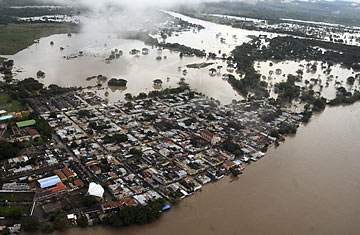
Handout picture relased by Antioquia's provincial government showing an aereal view of floods in Puerto Nare municipality, Antioquia, Colombia on April 24, 2011.
In the novel One Hundred Years of Solitude, a five-year-long downpour imprisons people in their homes, washes away the banana plantation and reduces the town of Macondo to ruins. But the deluge dreamed up by Colombian novelist Gabriel García Márquez in his magical-realist masterpiece pales compared to the real-life flooding of his homeland now.
Amid 11 months of nearly nonstop rain, dykes have burst and rivers have topped their banks, inundating communities, cattle ranches, and croplands in 28 of Colombia's 32 departments. Waterlogged Andean mountainsides have collapsed, burying neighborhoods and blocking highways. More than 1,000 people have been killed, injured or gone missing. In the flooded town of Puerto Boyacá in central Colombia, coffins holding the dead are being floated to the cemetery on boats.
All told, more than 3 million people — nearly 7% of Colombia's population - have been displaced or have suffered major water damage to their homes and livelihoods. President Juan Manuel Santos calls it the worst natural disaster in the country's history, one his government predicts will shave 2.5% from Colombia's 2011 GDP. Yet hardly anyone outside of Colombia has noticed because the tragedy, unlike an earthquake or hurricane, has unfolded in slow motion. "Drop by drop the rain causes more damage every day," Santos said recently. "It's like Chinese water torture."
Santos and other government officials blame La Niña, the weather phenomenon that causes unusually cold temperatures in the Pacific Ocean along the equator and provokes heavy rains. La Niña kicked in around the middle of 2010, dumping five to six times the average amount of precipitation on some parts of Colombia. And there's been no respite. Last year's wet weather continued through what is normally Colombia's dry season and merged with the current rainy season.
Complicating matters is extreme geography. Colombia is divided by three Andean ranges, and the rain-saturated mountain soil is crumbling away, causing daily landslides as well as sedimentation — which raises water tables in rivers. One of the hardest-hit cities is Cúcuta, located on the Venezuelan border. Cave-ins and landslides have blocked highways leading to Bogotá and the Caribbean coast, leaving residents largely cut-off from the rest of the country. Ironically, Cúcuta also lacks drinking water because so much rain has increased sediment in local rivers, overwhelming the city's water purification system.
Santos has toured some of the worst flooded areas, but the government's response has been marred by bottlenecks and graft. Due to the isolation of flooded villages, the inexperience of local officials and the presence of rebels and drug traffickers, just four of 753 public works projects to repair roads, bridges, homes and schools are underway. Four governors and 26 mayors are being investigated for allegedly mishandling flood assistance. Outraged victims have blocked highways in protest.
Yet long before the rains hit, Colombian officials had paved the way for this tragedy. They allowed developers to build housing projects in flood plains and failed to shore up retaining walls and dykes. Poorly designed drainage systems mean even modest rain showers can turn streets into lakes. Meanwhile, efforts to design modern highways that can better withstand heavy rains have hit speed bumps. On Tuesday, Colombia's inspector general suspended Bogotá Mayor Samuel Moreno from his post temporarily amid a widening kickbacks scandal involving road-building contracts. (Moreno denies involvement.)
As for the country's waterways, reengineering has made some even more prone to flooding. "These are natural catastrophes but, essentially, they are man-made," Bruno Moro, the U.N. Humanitarian Coordinator in Colombia, told TIME. A vivid example is the Bogotá River, which runs through the capital and has become an all-purpose dumpster for garbage, sewage and industrial runoff. The waste plus the rerouting of streams into the river have swelled water levels, and massive earthen embankments are now required to keep the river on course. To make matters worse, the dykes sometimes fail.
The Universidad de la Sabana (University of the Savanna), one of the Colombia's elite academic institutions, sits next to the Bogotá River in the capital suburb of Chía. On April 25, the surging river punched a 60-ft.-long hole (18 m) in a nearby levee. Now, the university's library, amphitheatre and science laboratories sit five-feet deep (1.5 m) in putrid black water. As he climbed into an aluminum boat on a mission to salvage classroom desks and computers, volunteer relief worker Luis Gabriel Angel said: "Nobody imagined the flooding would be this bad."
Fortunately, the downpours won't last as long as they did in the fictional Macondo. Forecasters predict the rain will peter out by July. But thanks to global warming and climate change, Colombians should get used to extreme weather, says Ricardo Lozano, who heads the government's Institute of Hydrology, Meteorology and Environmental Studies. He points out that just before the floods, Colombia suffered through a lengthy drought. "It's wrong to think that climate change is a future threat because it is taking place right now," Lozano says. "The world should learn from what's happening in Colombia."
